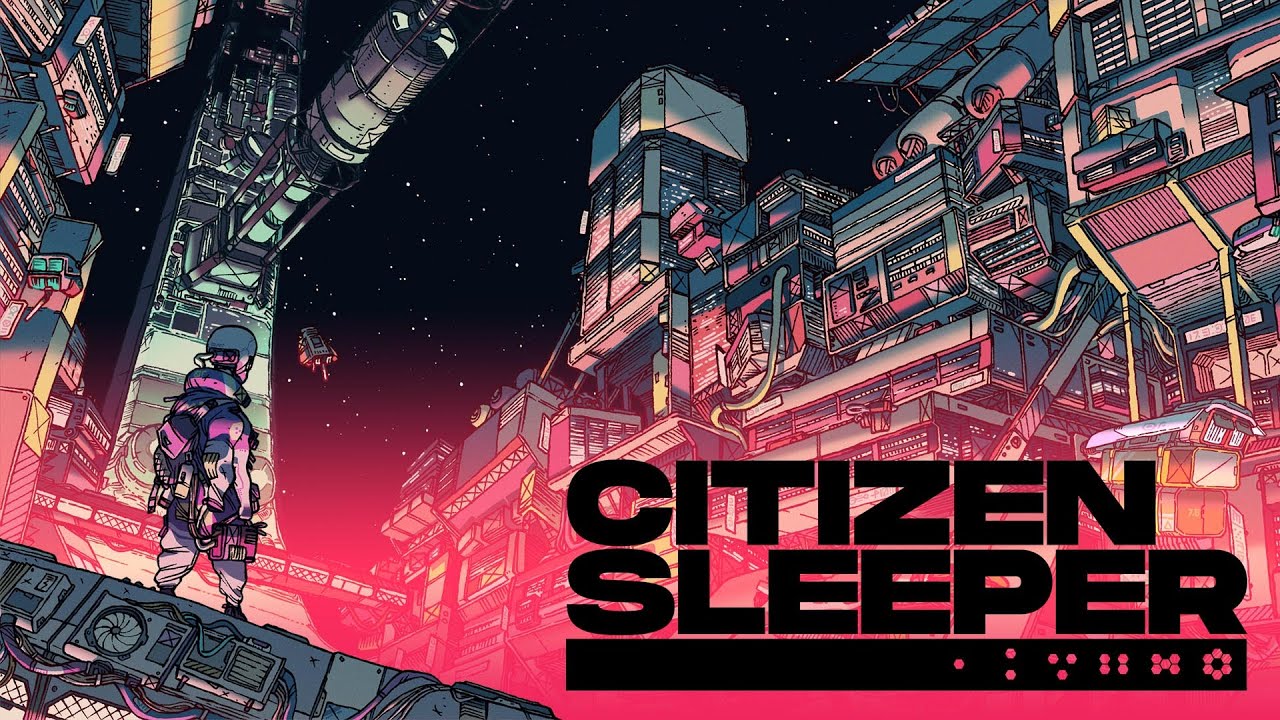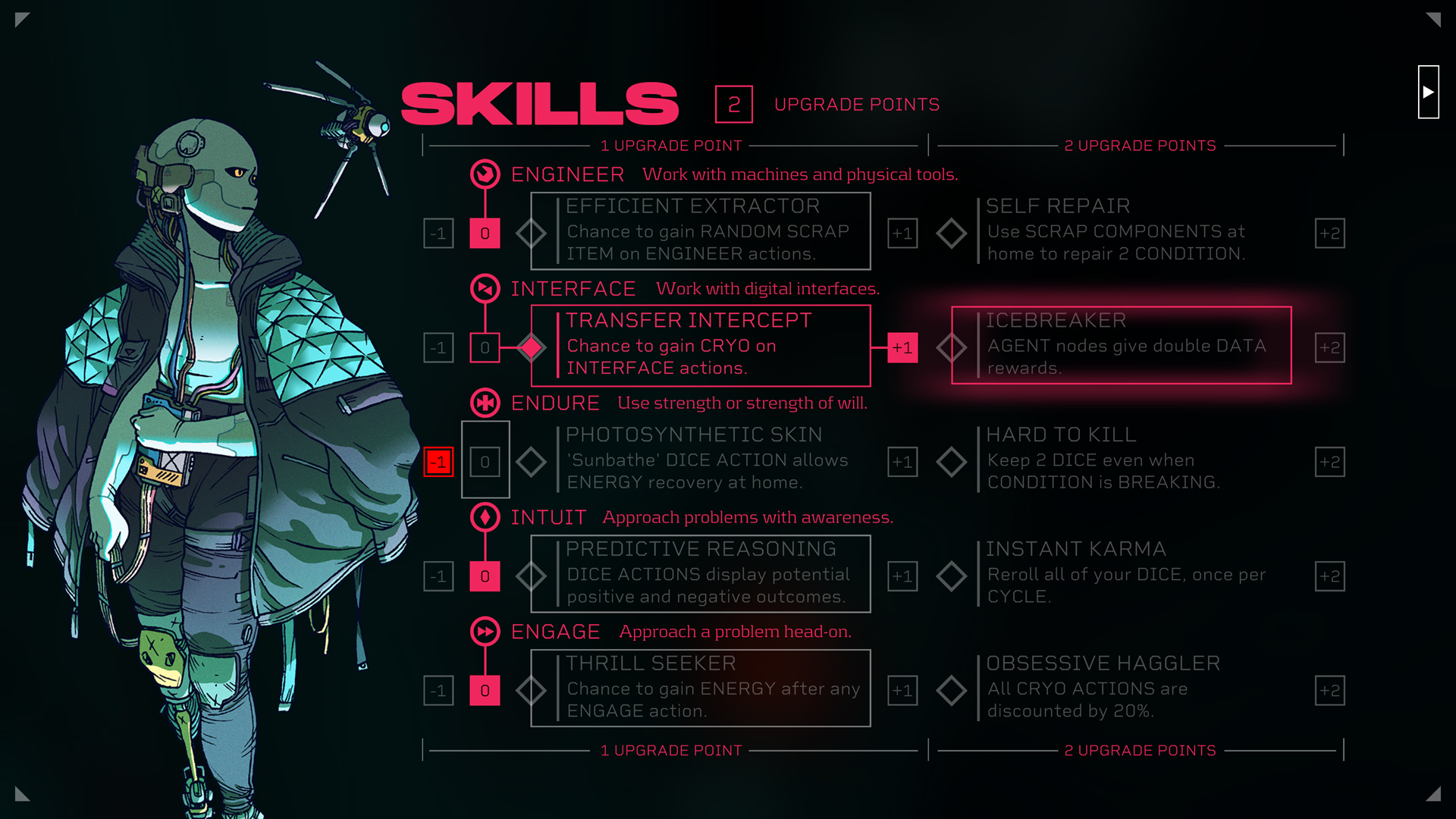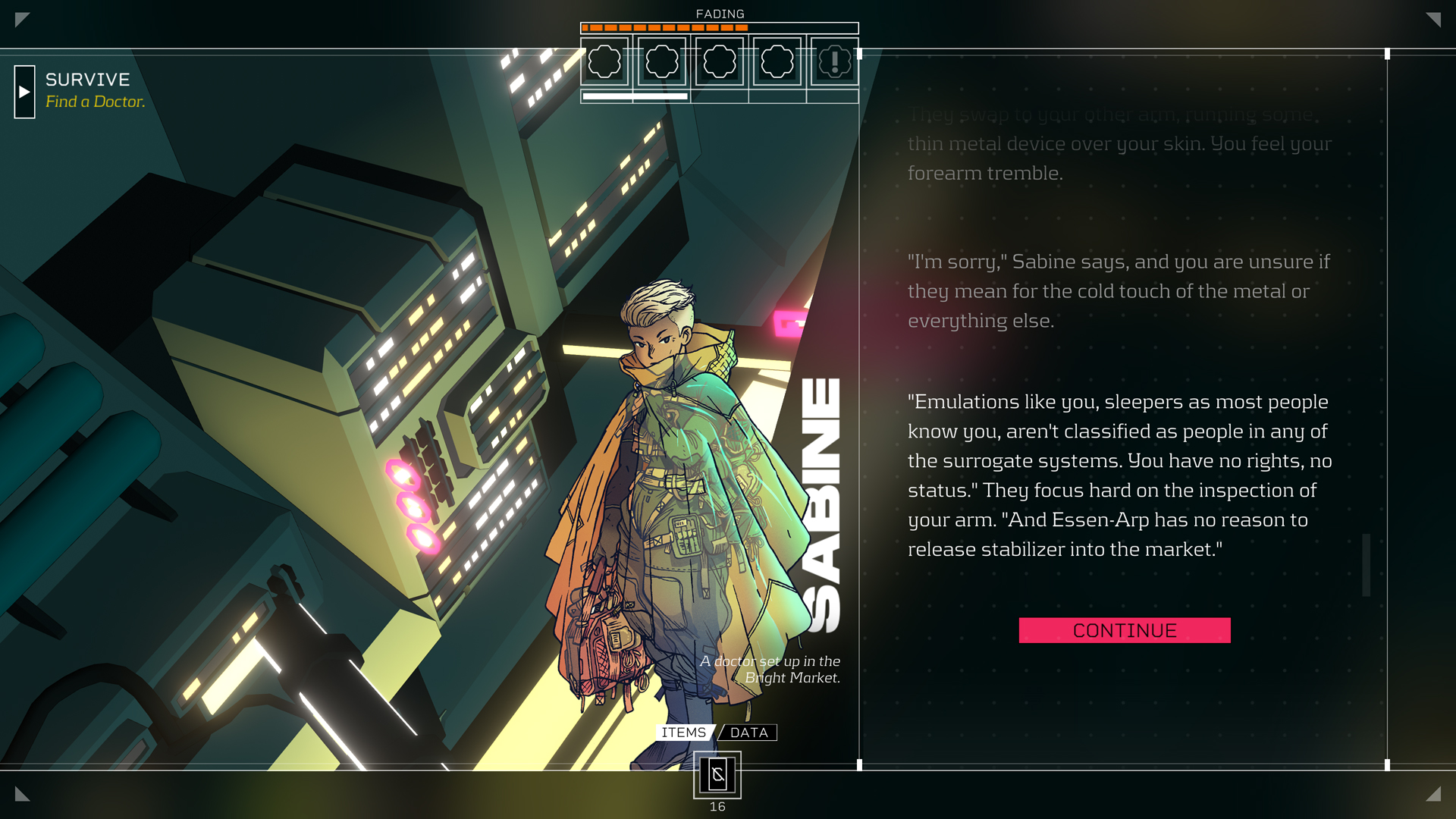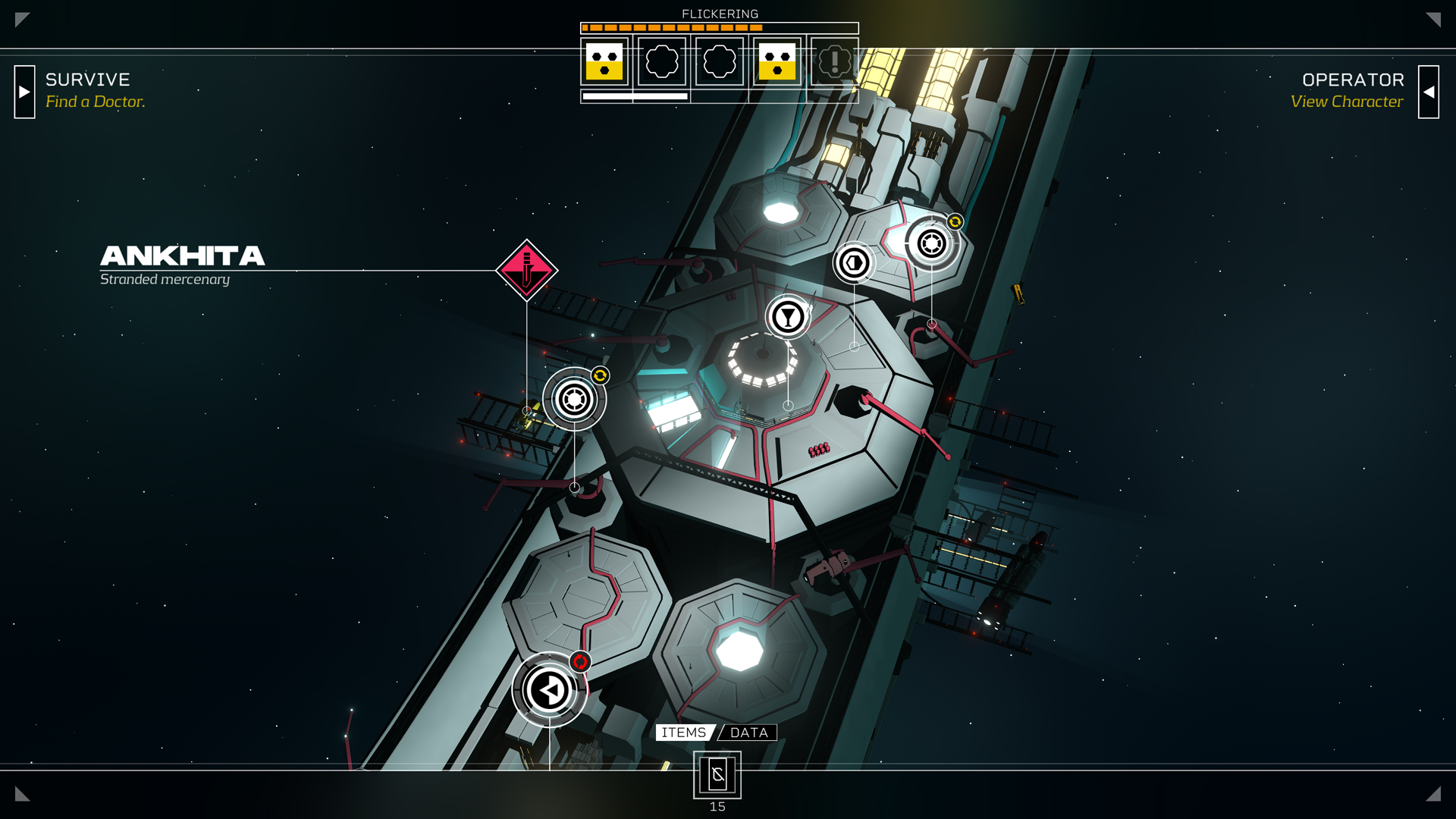In the dark reaches of space, among the likes of corpos and bounty hunters, there is a ring called Erlin’s Eye. It is fractured and broken, but it supports life. Your life. In Citizen Sleeper, you are a refugee from another planet starting life anew on the Eye. This is the spark that ignites the cyberpunk RPG from Jump Over the Age, the moniker of solo developer Gareth Damien Martin, who made the game with some help from artist Guillaume Singelin and musician Amos Roddy.
This innovative role-playing experience takes direct inspiration from modern tabletop RPGs. Citizen Sleeper is dense with systems, but once you are past the learning curve, you will find a rich sci-fi world full of scrappy, endearing characters.
Citizen Sleeper Review: The Good Life is Just a Dice Roll Away
Citizen Sleeper is fundamentally about rolling dice and watching meters fill. That description does little, though, to evoke the tension and on-the-fly decision-making that turn Citizen Sleeper into a sci-fi RPG that weaves many genres of cyberpunk together inside a cohesive space. Especially impressive since you don’t see much of that space; a large portion of Citizen Sleeper’s world is described through text.
In this world, you are an emulation of a person that embodies a machine called a Sleeper. Someone sold their consciousness to a corporation, and you are the workhorse they have created using a copy of that human’s intelligence inside a robotic body. Escaped from your life of servitude, you still suffer detrimental side effects from when a company owned your body.
Each morning you wake to a new cycle featuring a dice roll and two decreasing meters. One of these you must keep up with food and other energy recovering activities and one that requires a special (and expensive) antidote, called Stabilizer.
For the first two-thirds of Citizen Sleeper, it is the precious resource you must juggle all your other resources to obtain. To do so, you must spend dice to complete odd jobs around the city, making enough money to survive. It’s a balancing act that drives the moment-to-moment gameplay. In fact, Drives are exactly what Citizen Sleeper calls its quests, a stylistic flair emblematic of the engrossing writing that appears all over.

By moving from node to node on the map, you find various ways to spend your dice, either by doing jobs or hacking. An action can have three possible outcomes: positive, neutral, or negative. The likelihood of each outcome is determined by which dice you spend. Roll a 5 and that’s a 50/50 shot at neutral or positive. Roll a 3 and your odds are 25/50/25. Bonuses on actions are determined by stat points.
Hacking works differently. Once unlocked, viewing the Eye in hacking mode allows you to see modules that take specific dice numbers. It’s a smart way to spend your low-value dice, giving even traditionally “bad” roles some value.
Positive and neutral outcomes fill up Citizen Sleeper’s various clocks. Another cue taken from TTRPGs, the clock system is one of many unique and fascinating systems. Occasionally, you will need to complete an action numerous times to advance a clock, but other clocks tick down. You don’t always know what is coming when a clock reaches its end, lending a constant sense of dread and anxiety to the proceedings.
Like all other mechanics in Citizen Sleeper, clocks are thematic and mechanical choices. The Working Class dread and fear that you can’t afford the next medical mishap. These are passed on to you when you cross your fingers that a dice roll goes your way, or when that final red tick fills in on clock counting down to “something” ominous.
Citizen Sleeper is best on PC and the only major quibble I have is in navigating the map and menus with a controller. Playing on Xbox (where many will likely check out Citizen Sleeper via Game Pass), moving to the node you want is occasionally imprecise, making for a good deal of fiddling around between actions. This hits the Drives and Skills menus the hardest, both of which feel most built for a mouse interface. I frequently encountered bugs in these menus that had me strangely navigating both the menu and the map at the same time.
Citizen Sleeper is a dialogue-heavy RPG about managing your resources and making choices, all for the sake of pushing forward the many compelling plot threads. Comparisons to Disco Elysium already feel a little too easy — and frankly, Citizen Sleeper is a more inventive use of dice — but it is not a bad point of reference. Both have excellent writing that focuses on telling a story while building mechanics through player choices instead of using traditional fail states.
The stunning character art goes a long way to convey the cyberpunk imagery the prose so often evokes. The portraits of the various people — ahem, sentient entities — are detailed and stylish. Everyone is effortlessly cool yet lets their character through in their design. I felt compelled to see pretty much every storyline for more of the characters, even the ones I discovered far too late.
The killer synthwave soundtrack by Amos Roddy is the cherry on top of the clean minimalist aesthetic. Music, too, is used to communicate themes and emotions during dialogue-heavy sequences.
Many of the character-driven narratives expand and intertwine, leading you to various endings. Some are simply bittersweet moments, but Citizen Sleeper is the sum total of all its parts. There is no main storyline. Instead, what you decide to focus on and how you spend your resources dictate the threads you see through and which ending you see first.
On the Eye, you may meet the slum doctor Sabine, who is in deep trouble with one of the local gangs. You may run into Lem and his daughter Mina as they struggle to make ends meet in poverty on the ring. There is a sentient vending machine, too, and while that sounds silly, it slowly builds to being one of the most profound storylines in the game.
Each plotline fleshes out its characters while exploring the political issues of the world. The power struggle for Erlin’s Eye between local organizations and galactic corporations leaves the working class out to dry. There is an impressive breadth to the sub-genres Citizen Sleeper’s dozen or so narrative threads cover. From a William-Gibson-inspired hacking odyssey to the more subdued personal narratives with sci-fi twists, each plot thread is memorable and meaningful.
On the whole, the writing needs to do the heavy lifting in terms of both characterization and world-building for Citizen Sleeper’s minimalist style to work. Thankfully, it does and is confident in its choices.
It took me about 40 or so cycles to see an ending, and regardless of which one you choose or stumble into first, you will be able to return back to the world. I played for almost 60 cycles by the time I tied off all my loose ends. You’ll be glad you did, too, since every plotline has an emotional or intellectually interesting ending.
Citizen Sleeper Review — The Bottom Line
Pros
- Builds a compelling cyberpunk world despite most of the game being text.
- An inspired use of dice results in a one-of-a-kind gameplay experience.
- Deep well-drawn characters with rich storylines.
- A soundtrack you can vibe to in and out of the game.
Cons
- Buggy UI on consoles.
Citizen Sleeper is an innovative cyberpunk RPG that understands the core tenants of the genre better than most AAA attempts. With deeply sympathetic (and extremely cool) characters, it builds its punishing post-capitalist society on the back of some of the best descriptive prose I’ve seen in a video game. The only caveat is to play with a mouse and keyboard if you can.
With mechanics inspired by contemporary tabletop RPGs, Citizen Sleeper feels fresh, tense, and engaging throughout its 6- to 8-hour run time. Balancing your actions, resources, and story progress is a tight-rope act that’s engrossing the further you get into this stellar sci-fi world.
[Note: The Game Pass version of Citizen Sleeper was used for this review.]










Published: May 11, 2022 03:30 pm